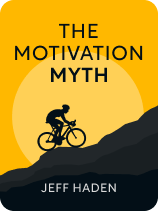

This article is an excerpt from the Shortform book guide to "The Motivation Myth" by Jeff Haden. Shortform has the world's best summaries and analyses of books you should be reading.
Like this article? Sign up for a free trial here.
What is a productivity marathon? How can you stay productive all day?
With phones and email distracting us all day, it’s easy to slack off and get off task. By taking a productivity marathon, you can check off all the items on your list and stay focused on the task at hand.
Here’s how to stay productive all day, according to Jeff Haden’s book The Motivation Myth.
What Is a Productivity Marathon?
One way to make the most of your resilience is to occasionally concentrate your efforts in a day-long session to complete a major task toward your goal. A work marathon (or, in Haden’s words, an “extreme productivity day”) can knock a major step off your to-do list, motivating you to keep moving toward your goal while reducing the need for resilience by completely shutting out distractions. Haden lists steps for learning how to stay productive all day, how to stay energized and focused, and how to apply similar principles for an entire week or more.
(Shortform note: Though Haden discusses productivity marathons as solitary ventures, they don’t have to be. In Sprint, Jake Knapp, John Zeratsky, and Braden Kowitz explain how to implement a productivity marathon for an entire team. The steps involved in setting up a group productivity sprint are very similar to those described by Haden below, although they need to be formalized and documented when applied in a business setting.)
First, it’s vital to let people know you’re going to be unavailable. Schedule your concentration time as you would a vacation and dedicate yourself to working those hours. Also, make sure to book a long stretch of time. Haden says that spending long hours on a task is paradoxically easier since it frees you from having to monitor your schedule. He also suggests not beginning your marathon at the same time you’d normally start work. This session is meant to be a break from your habits, and one way to make sure that happens is to break from your routine. Also, by accomplishing more in a day than you normally would over several, a marathon recalibrates your expectations of how hard or how much you can accomplish at once.
(Shortform note: The sort of concentration Haden describes is what Cal Newport discusses in his book Deep Work. Newport defines deep work as focused, uninterrupted, undistracted work on a task that pushes your cognitive abilities to their limit. While deep work is hard to carry out, it’s also much more fulfilling than the shallow tasks that normally fill your day. Whereas Haden focuses on secluding yourself as the best way to carry out deep work, Newport offers several alternatives, such as making it a regular part of your schedule or squeezing it in whenever the opportunity presents itself.)
While embarking on your productivity marathon, you balance taking care of your mental and physical energy needs with not letting yourself drift too far off task. Haden suggests eating snacks before you’re hungry and getting up to stretch your muscles before you start to feel tired. By the time your body sends you those signals, its reserves are already flagging.
(Shortform note: To maintain productivity, momentum, and motivation, self-care must be more than just an afterthought. In Make Time, Jake Knapp and John Zeratsky describe it as one of the essential pillars of time management, especially in a modern, sedentary workplace for which the human body isn’t designed. In addition to Haden’s suggestions to eat right and periodically stretch, Knapp and Zeratsky recommend methods to use caffeine strategically as well as ways to rest that maximize your energy.)
However, Haden also says to delay taking breaks (to reward your progress) longer than you normally would and to stop work in the middle of a task so that you know exactly where to pick up when you start going again.
(Shortform note: Haden’s advice to take your breaks in the middle of a task is a recommendation often given to writers—that you should stop in the middle of a chapter, or even a sentence—to make it easier to get back into the flow. The idea may have originated with Ernest Hemingway, who always quit work at a point when he knew what had to happen next in his stories. The idea has gained wider popularity as a tool to help reduce procrastination.)
Long-Term Productivity
Once you’ve felt the success of blocking off a day to accomplish one major step toward your goal, you can make use of similar tactics to optimize your motivation and resilience throughout the week. Begin by mapping out your weekly schedule, setting aside times for each task while being realistic about how long they’ll take. Don’t try to multitask, but make room to focus on one individual step at a time. Blocking out a whole week as you did for one day can help you identify where your slack times are and help you find more productive ways to use them.
(Shortform note: Haden skips a step in blocking out time, which is to build in protective buffers to keep tasks from conflicting. In Essentialism, McKeown describes buffers as a way to protect your mental space. A time buffer keeps travel delays from throwing you off schedule. Building time for questions into a presentation prevents you from speeding through important points you’d like to make. “Planning buffers” such as packing lists for trips reduce the risk you’ll forget something important, wasting precious mental and emotional energy as well as the extra time you’d need to readjust your plans.)
Nevertheless, you can’t stay busy 24/7. When mapping out a productive week, be sure to schedule time to turn your productivity off. Spend time with your family, go hiking in the woods, or have fun at the movies. Haden affirms that you should respect your leisure and family time so that it doesn’t get eaten away in your quest to pursue your overarching goal. It’s great to excel, but you must also live your life.
(Shortform note: In 168 Hours, Laura Vanderkam goes into more detail about how to block out and balance a productive week that maximizes time for your work and private life. To do so, she suggests recording your typical week in detail to better understand how you’re spending time already. Once you’ve done that, you can plan your time at work to focus on tasks that play to your strengths. At home, she recommends scheduling more time to spend with your loved ones and delegating time-consuming housework and chores if it’s cost-effective to do so.)

———End of Preview———
Like what you just read? Read the rest of the world's best book summary and analysis of Jeff Haden's "The Motivation Myth" at Shortform.
Here's what you'll find in our full The Motivation Myth summary:
- Why you should stop waiting for motivation to hit and instead, make your own
- How to create a cycle of positive reinforcement to boost your motivation
- How to develop resilience to get through times of struggle






